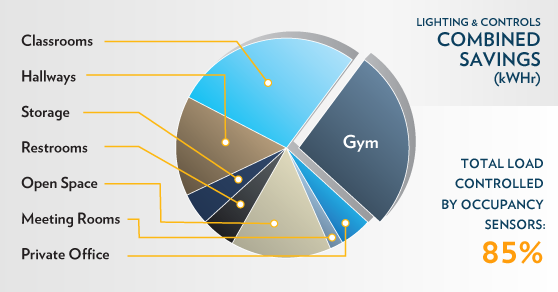General Area Type Case Study:
Universities & Colleges
In both universities and colleges, classrooms represent almost half of the lighting load of the whole school, however they only provide 25-30% of building’s potential energy savings. We look past just the classrooms and know that gyms and hallways each contribute 20-30% of the energy savings potential! The use of controls (sensors) add convenience to these applications while also adding an element of security. The following chart shows the area types, with both lighting and sensor upgrade savings potential:

Private Office
A common application representing 5-10% of the total building savings. Controls and lighting upgrades provide an improved working environment and convenience.
Open Office Space
Lighting upgrades improve the working environment, however an often overlooked application for controls, yet typically provides 10-20% building potential savings!
Meeting Rooms
An area type with fluctuating usage and often unoccupied with the lights left On. Popular application for Controls and Lighting providing 2-5% of the total building’s savings.
Hallways
With long run hours, Lighting upgrades are common. However, this is an ideal application for Controls providing, 15-20% of the building’s potential savings! Sensors add convenience and an element of security.
Storage
The infrequent use makes this an ideal application for Controls, providing 4-6% of the buildings potential savings. A common retrofit of Incandescent to LED or Fluorescent and keeping the annual usage to a minimum with the sensors, means these lights will almost never need maintenance.
Restrooms
Sometimes a difficult application due to the partitioned stalls. Properly applied Microphonic technology sensors, however, resolve this issue, allowing for 4-6% of the building’s potentials savings. Additional savings can be obtained by controlling the exhaust fans as well.
Gyms
A large lighting load that is ideal to be retrofitted from HID to Fluorescent or LED. Once retrofitted, sensor controls reduce the operation time significantly providing 25-30% of the building’s potential savings. Typically this application is the best return on investment in a school.
Classrooms
Although classrooms represent half of the lighting load in a school, they only provide 20-35% of building’s potential savings. Lighting upgrades can improve the educational environment, while being an excellent opportunity for dimming controls.